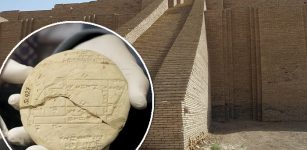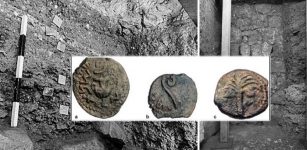1,700-Year-Old Vase For Olive Oil And Wine Unearthed At Historic Site Of Diyarbakir Fortress, Turkey
Conny Waters - AncientPages.com - A very unique 1,700-year-old amphora was unearthed by archaeologists conducting excavations at the Diyarbakir Fortress site, located in the historic Sur district in southeastern Turkey.
The amphora was once used for delivering olive oil and wine, and no doubt, it has its own history.
The excavation in the area of the fortress where the amphora was discovered was launched around three months ago, informed archaeologist Süleyman Karakas. He also added that the team excavating in the area, found architectural structures from the Roman, Byzantium and Ottoman periods in the fortress.
“The sharp-bottomed amphora is crucial as it was made for trade,” he said, as he noted that the vase was well-preserved. He continued by saying that the finding has excited archaeologists in the region because it is the first such discovery.
“We do not think the amphora was brought here for trade reasons because we would have come across other examples if that was the case,” Karakas said, as cited by Daily Sabah.
Diyarbakir Fortress and the city walls have guarded the city for thousands of years as if they were guarding a holy relic by surrounding it magnificently. This ancient site still carries a medieval atmosphere with its almost intact and impressive walls encircling the city that stand up to 12 meters (39 feet) high and 5 meters thick.
City Wall and Battlements - Diyarbakir - Turkey. Image credit: Adam Jones - CC BY-SA 2.0
With its length of nearly 6 kilometers (3.7 miles), the city walls of Diyarbakir remain the second-largest city walls in the world after the Great Wall of China.
The walls are situated 100 meters above the valley of the Tigris.
Diyarbakir fortress is constructed with stone, black basalt, and adobe, and has gone through countless renovations; the basalt fortifications are exceptionally durable, one reason why the structure has remained relatively intact for more than two millennia. It was first built in 297 AD by Romans.
In 349 AD the walls got significantly expanded under the order of Emperor Constantius II. Over the next 1500+ years, these walls were expanded and fortified using volcanic rock from the surrounding region. There are four main gates and 82 watch towers on the walls.
The fortified city of Diyarbakır and the landscape around has been an important centre since the Hellenistic period. source - whc.unesco.org
Southeastern Turkey's Diyarbakir province stands today as one of the oldest cities in Mesopotamia, home to thousands of years of history.
The discovery was made during the fifth stage of the excavations, funded by the Ministry of Environment, Urban Planning and Climate Change and jointly carried out by the Diyarbakir Museum Directorate.
Sermed Azizoglu, an official from the municipality’s construction affairs office, told Anadolu Agency (AA) that they would like to pass on the fortress’ 2,000-year-old heritage to the next generations.
The Fortress is one of UNESCO World Heritage sites along with the 8,000-year-old Hevsel Gardens, 700 hectares of cultivated, fertile lands that in history played a vital role in keeping the city provisioned and supplied with water.
Written by Conny Waters - AncientPages.com Staff Writer























